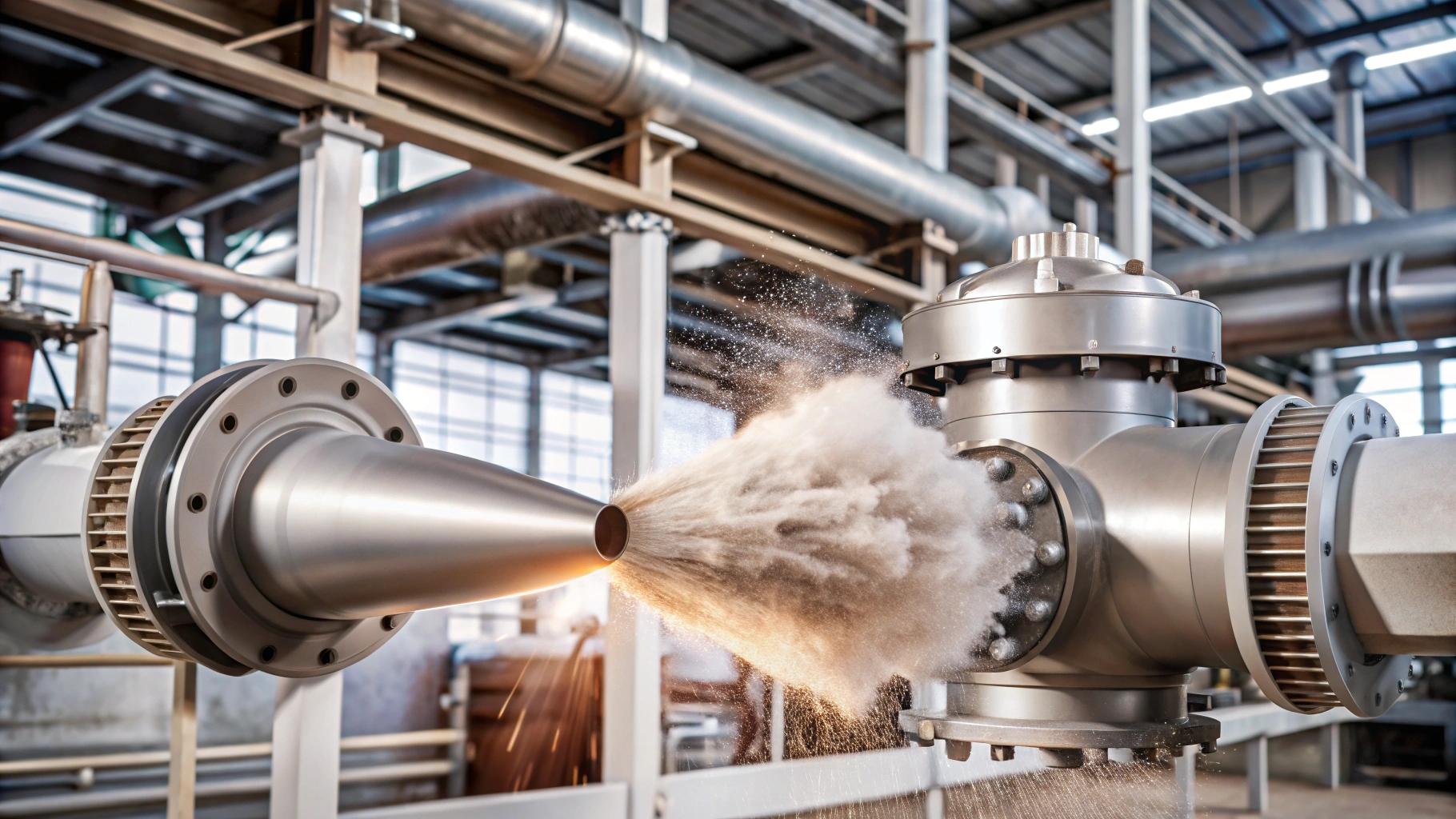
The electromagnetic pulse valve plays a crucial role in various industrial systems. It is commonly used in pulse-jet bag filters, where its function directly impacts the overall performance of dust collection and filtration systems.
An electromagnetic pulse valve controls the release of compressed air used to clean filter bags in pulse-jet filtration systems. This process is vital in maintaining filter efficiency by dislodging accumulated dust and debris from the filter media. Without the proper functioning of this valve, a filtration system would quickly become clogged and inefficient.
What is the Purpose of the Electromagnetic Pulse?
The purpose of the electromagnetic pulse1 in a pulse valve system is to trigger the release of compressed air at specific intervals. This pulse of air causes a strong burst of air pressure to clean the filter bags2, removing the trapped dust and particulate matter. The cleaning action helps to restore the filtration system3’s efficiency, ensuring that it continues to operate effectively.
The pulse valve4 is an essential component of the cleaning mechanism in pulse-jet filters. By managing the timing and strength of the air pulse, the valve ensures that the system cleans the filters at regular intervals without causing damage. This process helps to maintain consistent airflow, preventing a buildup of dust that would otherwise hinder the performance of the filter.
What is the Purpose of the Electromagnetic Valve?
The electromagnetic valve5’s primary purpose is to control the flow of compressed air within the system. When the valve receives an electrical signal, it opens to allow compressed air to flow through it and into the filter bags6, generating the pulse of air needed to clean the filters. The electromagnetic control system ensures that the valve opens and closes precisely when needed, maintaining the balance between efficient cleaning and minimizing energy consumption.
Electromagnetic valves7 are commonly used in various industrial applications, including automation systems, fluid control, and pneumatic control systems, due to their precision and reliability. In the context of a pulse-jet filtration system, the electromagnetic valve plays a pivotal role in the effectiveness of dust collection and filtration.
How Does a Pulse Valve Work?
The operation of a pulse valve8 involves several steps, all controlled by electromagnetic signals9 that ensure the release of compressed air is timely and effective.
Basic Structure
A pulse valve typically consists of a valve body10, diaphragm11, solenoid coil12, and other essential components. The valve body holds the diaphragm, which controls the airflow, and the solenoid coil, which provides the electromagnetic signal.
The solenoid coil, when energized, creates a magnetic field that moves the diaphragm, opening or closing the valve. The flow of compressed air through the valve is controlled by this movement, allowing for the release of air in a controlled burst.
Working Process
The pulse valve works by receiving an electrical signal from the control system. When the system sends a pulse, the solenoid coil energizes, creating a magnetic field. This field pulls or pushes the diaphragm, opening the valve. As the valve opens, compressed air flows through the valve and into the filter bags, producing a powerful burst of air. This pulse of air forces the dust and debris out of the filter media, clearing it for further filtration.
Control Mechanism
The operation of the pulse valve is carefully controlled by an electrical control system13. The system sends signals to the solenoid, triggering the opening of the valve. The coordination of electrical and pneumatic control ensures that the pulse valve releases air at the right time and in the right amount to achieve optimal filter cleaning without wasting energy.
The timing of these pulses is essential to the performance of the filtration system. Too frequent or too strong pulses can damage the filters, while too few or weak pulses will fail to clean the filter adequately.
The Key Features and Advantages of Electromagnetic Pulse Valves
Long Lifespan
Electromagnetic pulse valves14 are designed to be durable, with high-quality materials and robust construction that ensures a long operational life. Their longevity is vital in industrial settings where maintenance costs and downtime need to be minimized.
Manufacturers of pulse valves often design them with wear-resistant components and advanced sealing technologies15 to withstand the constant cycling of opening and closing, reducing the need for frequent replacements.
High Efficiency
The performance of the electromagnetic pulse valve significantly impacts the efficiency of the entire filtration system16. The valve's flow capacity, pressure rating, and response time determine how effectively it can generate the necessary pulse to clean the filter bags.
A high-performing valve can ensure that the filtration system works efficiently, minimizing energy usage while maintaining high levels of filtration and cleaning performance. This is especially important in industries where dust control is critical, such as cement production17, mining18, and chemical manufacturing19.
| Feature | Benefit |
|---|---|
| Flow Capacity | Allows for efficient air burst to clean filters |
| Pressure Rating | Ensures the right force for effective cleaning |
| Response Time | Minimizes downtime, providing quick cleaning action |
Low Power Consumption
One of the most significant advantages of electromagnetic pulse valves is their low power consumption. The solenoid only requires power when it is activated, making these valves highly energy-efficient. This low power consumption helps reduce overall operating costs, especially in large-scale industrial systems.
Reliability
Pulse valves are designed to be reliable, even in demanding environments. In industrial applications where the systems often operate under heavy loads, electromagnetic pulse valves are engineered to maintain consistent performance and reduce the likelihood of system failures. Their reliability ensures that filtration systems can run smoothly for extended periods, even under high stress.
The Technological Advantages of Electromagnetic Pulse Valves
Quick Response
One of the standout features of electromagnetic pulse valves is their rapid response time. When triggered, the valve opens almost instantaneously, allowing for the immediate release of compressed air. This quick response ensures that the cleaning process is efficient and timely, which is crucial in maintaining consistent airflow and preventing filter clogging.
High Airflow Impact
The electromagnetic pulse valve is capable of generating a powerful air blast, which is critical in dislodging dust and debris from the filter media. The strength of the air pulse produced by the valve is directly tied to the valve’s design and size. A high airflow impact ensures that the pulse-jet filtration system can remove even the most stubborn dust particles, maintaining clean filters and a high-quality air output.

Adjustable Performance
Many modern electromagnetic pulse valves come with adjustable features, allowing operators to fine-tune the air release according to the specific needs of their filtration system. This adjustability allows the valve to operate under various conditions, optimizing the cleaning cycle for different dust levels, filter types, and operational environments.
High Temperature and Corrosion Resistance
Electromagnetic pulse valves are often built to withstand harsh environmental conditions. In applications where high temperatures and corrosive elements are present, these valves are constructed with special materials that offer enhanced resistance to heat and corrosion. This design ensures that the valve can continue to perform reliably in challenging environments, extending its service life.
Conclusion
The electromagnetic pulse valve is an essential component in the operation of pulse-jet bag filters. Its role in cleaning and maintaining filter efficiency cannot be overstated. With features like long lifespan, high efficiency, low power consumption, and reliability, it ensures that industrial filtration systems perform optimally, contributing to cleaner air and more efficient operations.
-
Explains the electromagnetic pulse concept and its role in pulse valve systems. ↩
-
Provides an overview of filter bags and their importance in air filtration systems. ↩
-
Describes the functioning of filtration systems and their role in maintaining air quality. ↩
-
Details the pulse valve's function and its importance in maintaining clean filters. ↩
-
Explains the working principle of electromagnetic valves and their industrial uses. ↩
-
Provides an overview of filter bags and their role in dust collection and filtration systems. ↩
-
Describes the various industrial applications and benefits of electromagnetic valves, including in filtration systems. ↩
-
Explains the basic functioning and importance of a pulse valve in filtration systems. ↩
-
Provides an overview of electromagnetic signals and their role in controlling pulse valves. ↩
-
Describes the valve body and its role in controlling airflow in a pulse valve. ↩
-
Details the diaphragm's role in regulating airflow in pulse valves. ↩
-
Explains the function of the solenoid coil in pulse valves and its role in airflow control. ↩
-
Discusses how electrical control systems work with pulse valves to regulate their operation. ↩
-
Describes electromagnetic pulse valves and their long lifespan in industrial applications. ↩
-
Explains sealing technologies used in electromagnetic pulse valves to enhance durability. ↩
-
Provides an overview of filtration systems and their role in dust collection. ↩
-
Explains the role of electromagnetic pulse valves in cement production for dust control. ↩
-
Describes the application of electromagnetic pulse valves in mining for efficient dust control. ↩
-
Explains how these valves are used for efficient dust collection in chemical manufacturing. ↩



